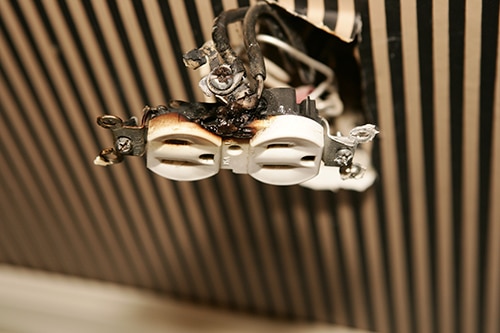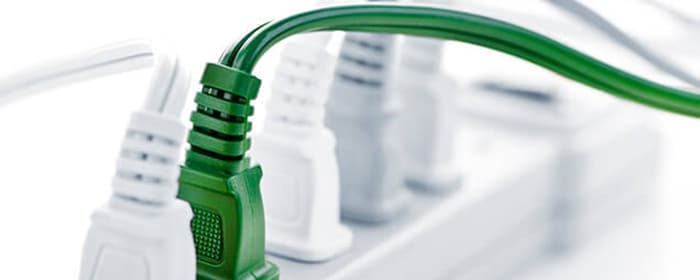How Do Surge Protectors Work?
A surge protector is more than just a power strip to give you additional useable outlets; it is an affordable way to protect your electronics from random power surges that can cause permanent electrical damage. Here is how surge protectors or surge suppressors work to protect your appliances and how to use them safely to prevent fires.
What Is a Power Surge?
To understand how surge protectors work, you need to understand what power surges really are. A power surge is simply an increase in the amount of voltage flowing through electrical devices that exceeds the standard voltage level of 120 volts. Surges can be caused by many things such as high-powered devices, bad wiring, incorrect lightning, or a problem with your utility company’s equipment.
You probably will not realize a power surge has happened until a device suddenly stops working. Your home may experience hundreds of electrical surges every year, sometimes without any damage.
Power surges can heat up wires and components in your electronics, similar to a light bulb filament, and cause them to burn out. Even when surges do not break an electronic, they can put excess strain on internal components and cause them to fail sooner than expected.
How Does a Surge Protector Work?
A surge protector guards against the damage that sudden power surges can cause. It works by pulling the current from one outlet and passing it through to the devices you have plugged into the surge protector. A surge protector contains metal oxide varistor, or MOV, which diverts any extra voltage to ensure devices receive a consistent power level.
The MOV works like a pressure-sensitive valve. When the MOV detects high voltage levels, it reduces resistance. If voltage levels are too low, it increases resistance. It will kick in automatically to redirect excess voltage.
A MOV has three components, including metal oxide that is connected to your power and grounding line by two semiconductors. The semiconductors have variable resistance that causes the electrons to move in a way that changes the resistance when the voltage gets too high or too low.
Power Strips vs. Surge Protectors: What’s the Difference?
Power strips and surge protectors may look alike, but they are very different. Both provide multiple outlets, but only a surge protector guards against power surges.
A power strip is typically just a low-cost, multi-outlet strip that expands your wall outlet. It may have a circuit breaker with an on/off switch, but it will not stop or reduce electrical issues.
Surge Protectors and Joule Ratings
You will notice that surge protectors have a level of protection measured in joules. This joule rating is an indication of how much energy the surge protector can absorb before failing. The higher the joule rating, the greater the protection the surge protector can provide by handling a single large power surge or many smaller surges.
What Should You Plug into Your Surge Protector?
As a general rule, you should prioritize using your surge protector for electronics that are expensive to repair or replace. Newer appliances are more sensitive to power surges than older electronics thanks to more delicate and smaller components. Microprocessors that are found in computers and many appliances are most sensitive to high voltage and only work when they receive a stable current within the right voltage range.
Examples of items that can be protected by a surge protector include:
- Computers
- Televisions
- Microwaves
- Modems/routers
- Video game systems (such as a PlayStation 4 or an Xbox One)
- High-end audio equipment
Surge Protectors Will Not Always Work
Unfortunately, it is a mistake to assume that your devices are 100% protected from surges with a surge protector. There are many reasons surge protectors may fail. For instance, surge protectors simply are not designed to last forever. Choose one with an indicator light that lets you know when the MOV has worn out. Many will continue to work but without the surge protection in place.
In addition, no surge protector inside your house guards against lightning. The good news is that lightning is an uncommon cause of power surges. The bad news? Surge protector strips are not able to handle a nearby lightning strike. If you feel you need protection against lightning or other serious surges, you can invest in a whole-house surge suppressor installed before your main electrical panel.
At Brennan Electric, we can help you to protect your entire home from power surges with affordable whole-house surge protection in the Seattle area. This type of protection can be used along with in-home surge protectors for the ultimate protection against electrical damage, including surges from lightning.
Keep in mind that a surge protector is only as good as your grounding. You will not get much benefit from a surge protector if you own an older house that has ungrounded outlets or you do not have proper grounding and wiring. This is because there will be no escape route for the excess voltage.
Using a Surge Protector Safely

Surge protectors work differently than power strips. A surge protector with an on/off switch and indicator light has a fuse that will melt if it overheats. This causes the space heater to lose the connection and power. However, not all surge protectors have this built-in breaker, and space heaters can easily overwhelm a surge protector.
To be on the safe side, avoid plugging high-power appliances like air conditioners and space heaters into a surge protector. Instead, plug these devices directly into a wall.
Tips for Choosing a Surge Protector
Now that you know what a surge protector is and how it works, make sure you know what to look for when buying a surge suppressor for your electronics.
Here are the most important things to consider:
- Think about what you want to protect.
- Get the right number of ports or outlets.
- Make sure it has a UL seal and it is a transient voltage surge protector.
- Check the clamping voltage and energy absorption rating.
- Look for a warranty.
- Make sure it has an indicator light.
Any surge protector you buy should be certified by Underwriter’s Laboratories (UL) and meet the minimum 1,449 standards. This is required for the surge protector to be labeled a “transient voltage surge protector.”
You will also want to check the energy absorption rating and clamping voltage. The first refers to how much energy the surge protector can absorb before failing and should be a minimum of 600 to 700 joules. Clamping voltage is the amount of voltage that triggers the MOV. Ideally, this should be 400 volts or less.
Turn to the Experts
Want the ultimate protection against dangerous power surges? Call Brennan Electric today to learn about whole-house surge protection in Seattle and request a free estimate. We can also help you with electrical repairs, installation, and maintenance as well as generator installation.



